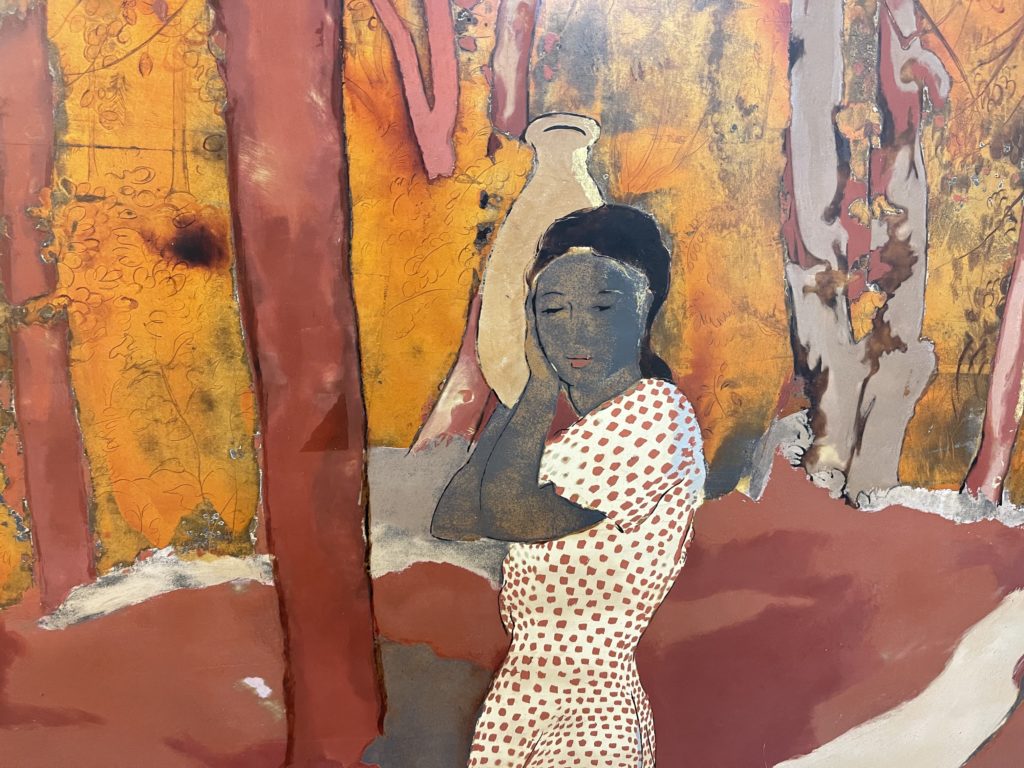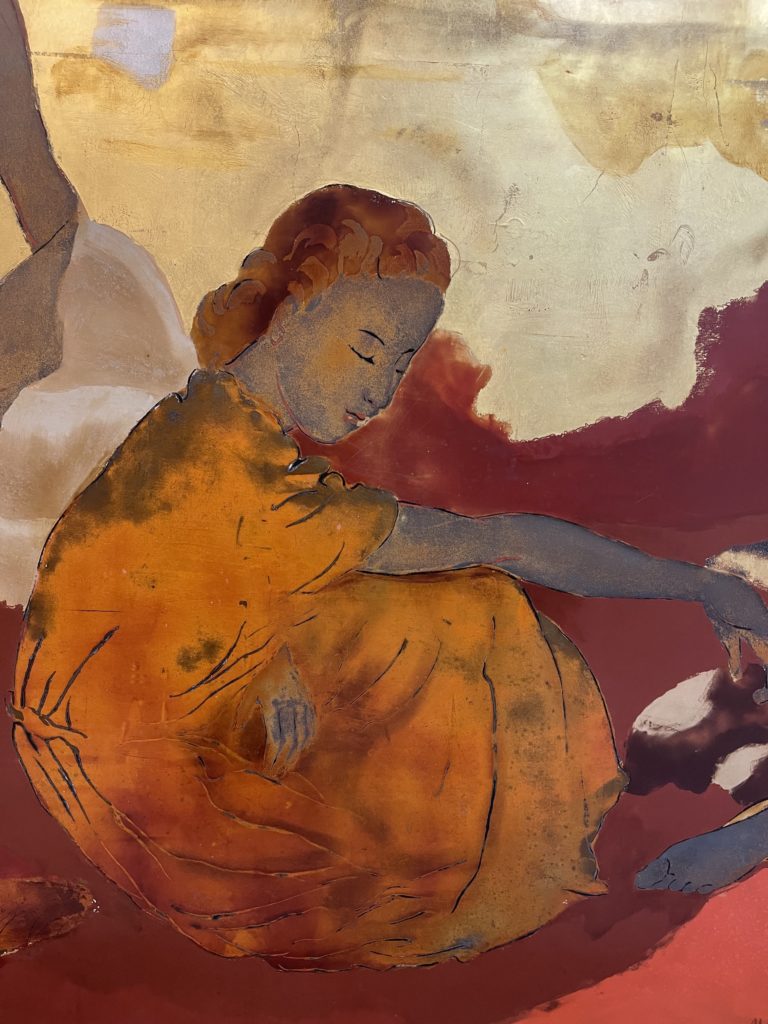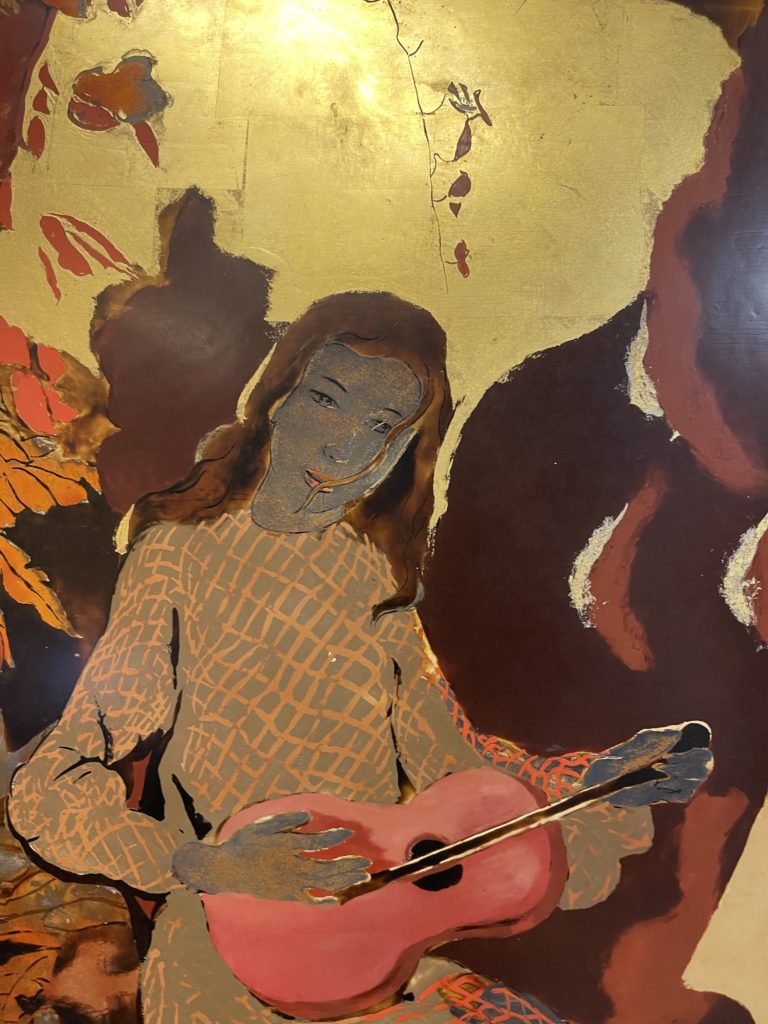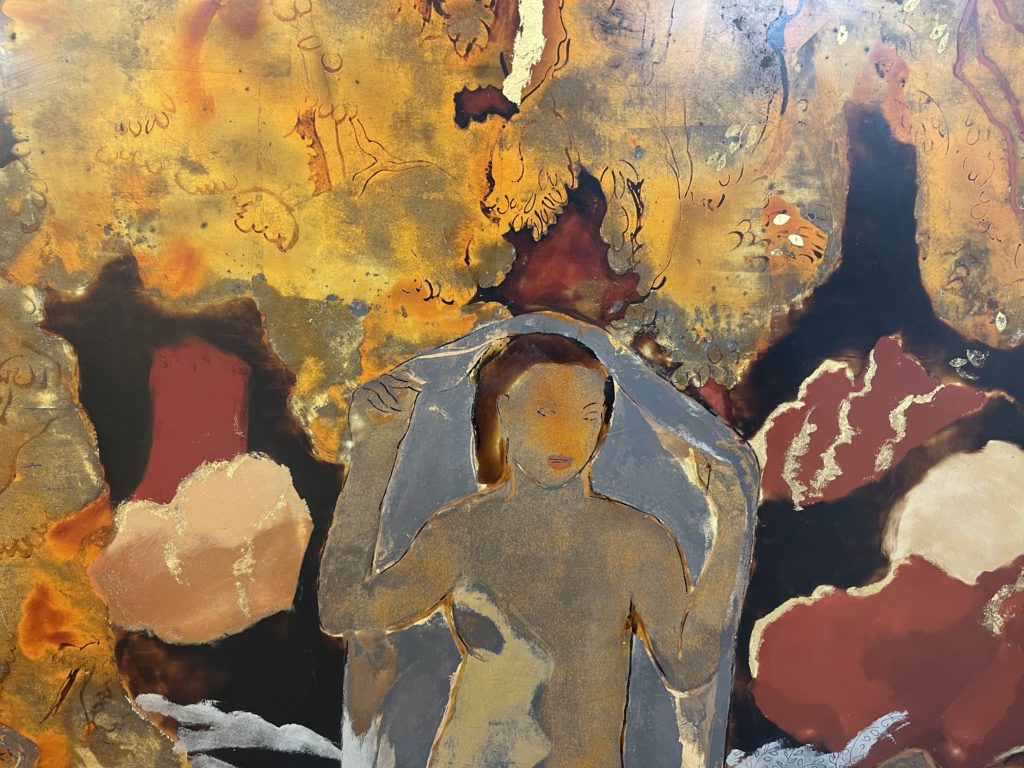Alix Aymé, « Pastorale », circa 1938 – 1940, or the presentiment of forbidden love
This iconic lacquer (150 X 229 cm) by Alix Aymé – who can never be praised enough for her essential contribution to Vietnamese painting – majestically gathers 10 women around a central pond, in a landscape more phantasmagorical than real.
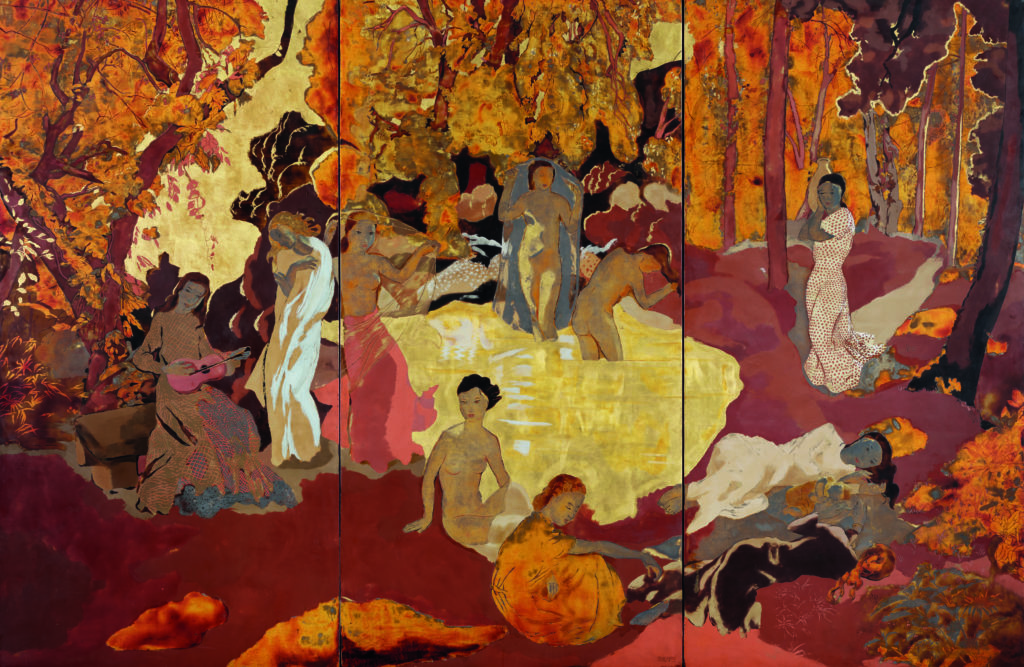
Young women, a central pond, phantasmagorical vegetation
Of the 10 women, 6 are clothed, 4 naked, totally or partially. One, seated on a bench, plays a stylized violin while another looks on, transfixed, almost in a trance. Another carries a jar on her shoulder, the contents of which we don’t know. Two more, sensually enjoying the water of the pond. One frolics, draped, while another, seated and naked, relaxes, almost posing. The one in the lower center, clothed and solitary, seems to be deep in thought. Finally, at bottom right, two others appear to be conversing, face to face.
The whole is more a gathering than a meeting, more a harmonious assemblage than a concerted assembly.
The disparity emanating from the work is illustrated not only by the diversity of postures, already mentioned, but also by the hair – 7 brunettes, 3 blondes, sometimes long, sometimes in a bun and sometimes in a “tomboy cut” – and by the faces – some Asian, others Western – but with no pronounced ethnicity for either, and by the loose dresses – far removed from traditional ao dai – in a variety of colors and patterns.
A calm, central, luminous pond centers the composition, based on gold, streaked and speckled with white. Flat areas of red lacquer in the lower left and upper right encircle it. The triangle formed by the women’s 3 light-colored garments further centers the composition.
Clear and inviting, the pond is occupied or encircled by 9 of the women. Only one, the jar-bearer, approaches from the right.
9 and 1: we’ll come back to this later.
The mutual absorption of Nature and man forms the basis of this image of Woman in a “paradisiacal” garden, in which the nuances and softness of the tones reveal the dreamy atmosphere of the place.
An almost phantasmagorical vegetation – in any case not very naturalistic – encompasses the whole and further reinforces the fusion. Note the absence of the sky…
Technique and principles
“Pastorale” illustrates the artist’s extreme talent in using all facets of the lacquer medium. A medium she began using in Hanoi as early as 1923 (although the date of the letter testifying to this may be disputed by a few years). (“I am also studying lacquer work with a Japanese man, with the aim of training a few students.” she wrote to Maurice Denis). It shows how she mastered the harmony of the three reds of cinnabar, yellow (cadmium sulfate), white (barium sulfate) and gold. Probably also silver, lead and zinc. It should be added that shimmer and matte are subtly used, and that the gold is no longer applied in thick incised layers as in some of her earlier works, such as the one in the Jean-Marc Lefèvre collection.
Basically, as in almost all her works, Alix Aymé pays homage to her main teacher, Maurice Denis (1870-1943), the great painter and theoretician of the Nabis, whom she met around 1917. True to what he wrote in an article for “Art et critique” in 1890:
“Remember that before being a warhorse, a naked woman or some anecdote, a painting is essentially a flat surface covered with colors in a certain assembled order.”
Which he completed in 1932:
“We wanted to emphasize the subjective, suggestive side of art. We felt that arabesque and the interplay of patches of color were enough to the expression of a painting.”
All principles that irrigate our lacquer.
Dating and significance
It’s often difficult to date Alix Aymé’s work precisely, given the artist’s multiform production.
However, we do know that she left for France in 1938 and returned to Vietnam in March 1940. Apparently, in the context of our dating, this was not a very long time to create a work of such dimensions (150 x 229 cms), given the slowness of lacquer production. But the use of preliminary drawings and tracings, often elaborated well in advance of the purely technical execution of the lacquer, mean that the visit to France does not compromise the 38-40 timeframe.
Two other works by the artist, fuller and more “ethnicized” Vietnam, were published in L’Illustration” – a special issue on Indochina – in 1949, as part of an article written by Alix Aymé herself, ‘Technique de laque’. Titled “Panneau décoratif sur fond or” (Decorative panel on gold background), and “Grand panneau décoratif : la Pastorale” (Large decorative panel: the Pastoral). Here again, the titles reflect the desire, inherited from the Nabis, to promote “decorative” art.
But our lacquer is not just a “decorative panel”. It is also, and perhaps above all, an ode to a project that the artist now feels to be inaccessible.
If the colors of the dresses are also those of the surrounding nature, ochre being the color of the trees and thickets, red the color of the ground, white the reflection of the pond, black (also the color of the hair) the color of the trunks and the background, does the fusion between beings and nature that they seek to demonstrate also concern a fusion between the beings themselves?
In this case of course, the people of Vietnam and the people of France.
Alix Aymé gives us her answer, symbolic but identifiable.

If we break down the three panels one by one, we can see that the one on the left symbolizes classical France and the one on the right, a secular Vietnam.
On the left, almost like the Renaissance.
On the right, effort and the outline of a face- to-face encounter, with the blonde protagonist symbolizing the French presence.
In the center, the confrontation that the artist foresees as an explosion.
The sensuality of the nude, the voluptuousness of the water, the esotericism of the place, the “garçonne haircut” are tempered by this young blonde woman, with Asian features, below, her eyes half-closed as if immersed in meditation.
Like two worlds that won’t fit together, as clearly felt by the artist.
Like a manifesto that the artist signs – precisely – at the bottom of the… central panel.
Alix Aymé has nurtured an almost carnal passion for Asia.
From Shanghai, discovered in 1920, to Hanoi where she visited as early as 1921, Yunnan-Fou (as early as 1921), Hué (1927), Vientiane, Luang Prabang and Cambodia (as early as 1929). In Japan, Manchuria and Peking (in 1936). Everywhere, and especially in Hanoi (where she stayed the longest), she was in search of the Asian soul, its distinction, its bewitching power.
Our lacquer shows the breathtaking culmination of this passion, a passion that the artist believes will soon be consumed.
In her lacquer, she recalls the painting “Les Muses” by Maurice Denis in 1893: a large format, muses, traditionally attached to an art or a domain of the spirit, but depicted here with no attributes likely to identify them, an almost sacred wood, elegant dresses, a general stylization. Much in common with our lacquer, but above all, as in this one, a “tenth” Muse (traditionally, there are only nine Muses…) Maurice Denis saw in it the elevation of the soul by the double grace of love and art.
Who’s the “tenth” here?
Alix Aymé and all.
But in an impossible fusion that sounds like a farewell. History will confirm the artist’s premonition.
Very quickly.
Jean-François Hubert
